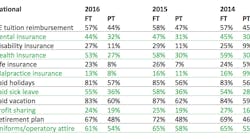2016 RDH eVillage salary survey, part 2: The employee benefits landscape remains unchanged
The availability of employee benefits within the dental hygiene profession has not changed much within the last three years, according to a comparison of statistics generated by the 2016 RDH eVillage salary surveys.
Among full-time dental hygienists, the fringe benefits of paid holidays and vacation remains fairly common. However, there were only four benefits (CE tuition reimbursement, health insurance, paid sick leave, retirement plan, and uniforms) available to more than 50% of full-time dental hygiene employees.
“Unfortunately, the hygiene schools have flooded the market and dentists are taking advantage of this,” a Maine dental hygienist said. “Many of the new hygienists are shocked at not being able to find a job and were told in school that many jobs were available. Schools have a duty to fill classrooms and keep their businesses going, but they should not misguide these students into thinking that they will be employed with a full range of benefits.
“Yes, many hygienists are retiring but, when the employer hires a new hygienist this position becomes low paying and without benefits.”
The RDH eVillage survey asked dental hygienists if an employee benefit was available to them at their place of employment, regardless of whether they enrolled or utilized the benefit. The specific state-by-state breakdown below lists employee benefits available to full-time and part-time dental hygienists.
The U.S. Bureau of Labor Statistics (BLS) updated its statistics for American workers’ access to health insurance, retirement, and life insurance benefits in March 2016. Several comparisons can be made with the dental hygiene profession.
Retirement benefits
- 88% of registered nurses have access to retirement benefits; only 67% of full-time dental hygienists do.
- Among American civilian workers, 80% who work full time have retirement benefits; 37% of part-time workers have access to the benefit. As mentioned above, 67% of full-time dental hygienists have retirement benefits, but 48% of part-timers have retirement benefits—higher than the national average.
- However, many dental hygienists still work for companies with fewer than 49 employees. Only 48% of American workers in smaller businesses have access to retirement benefits.
Health insurance
- 88% of registered nurses have access to health insurance compared to 53% of full-time dental hygienists.
- Among American private industry workers, 86% of full-time employees and 19% of part-time employees have access to health insurance. Again, part-time hygienists fared better overall, with 27% reporting the availability of health insurance.
- Smaller private businesses in the United States (under 49 employees) make health insurance available to 52% of workers.
Life insurance
- 77% of registered nurses have access to life insurance benefits. Only 23% of full-time dental hygienists do.
- Among American private industry workers, 71% of full-time employees and 12% of part-time employees have access to life insurance. Of the three benefits covered by the BLS update, dental hygiene lags behind with 23% for full-timers and 8% for part-timers.
- Even in a comparison with smaller business of fewer than 49 employees, 35% of American works have access to life insurance.
-----------------------------------------------
Click here to view Part 1 of salary survey: Are annual incomes as rosy as the forecasts?
-----------------------------------------------
A Nevada dental hygienist wrote in her response to the RDH eVillage survey, “The hygienists in my office saw two 5% pay cuts, loss of profit sharing plan, loss of health insurance at no charge in 2008 and 2009. This month, we lost office provided and laundered uniforms, as well as a week of our paid vacation time.”
A Virginia dental hygienist reported a similar experience, “Our benefits were cut in half in 2008, and we have never gotten back to that level. We have three paid holidays and three sick days. One week of vacation was taken away as well as disability. The doctors claim they are losing money every year. However, they continue to buy expensive equipment for them to use and seem to have no decrease in lifestyle.”
Upcoming reports on the 2016 RDH eVillage salary survey will review aspects of compensation for dental hygienists. Click on a state below to review the availability of benefits among hygienists practicing in that state.








